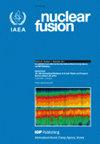Understanding the L-H isotope effect at the DIII-D tokamak and advancements in synthetic turbulence diagnostics
IF 4
1区 物理与天体物理
Q1 PHYSICS, FLUIDS & PLASMAS
引用次数: 0
Abstract
It is determined that while heat flux differences between hydrogen and deuterium isotope experiments result from natural differences in carbon impurity content at DIII-D, it is not the origin of the low to high confinement mode (L-H) transition isotope effect. More specifically, a two times larger edge radial electric field in hydrogen compared to deuterium is uncovered and believed to play an important role. The origin of this radial electric field difference is determined to have two possible origins: differences in poloidal rotation and turbulent Reynolds stress in the closed field line region, and increased outer strike point temperatures and space potentials on open field lines. Experimental observations from both profile and turbulence diagnostics are supported by nonlinear gyrokinetic simulations using the code CGYRO. Simulations illustrated heat transport isotope effects in the plasma edge and shear layer resulting from differences in impurity content, electron non-adiabaticity, and main ion mass dependent E × B shear stabilization. Turbulence prediction comparisons from flux-matched CGYRO simulations to experimental measurements including electron temperature, density and velocity fluctuations are found to be in good agreement with available data. A dedicated DIII-D experiment in hydrogen was performed to seed more carbon than naturally occurring, to match deuterium experiments, and possibly reduce the L-H power threshold based on gyro-kinetic predictions. To our surprise, while ion temperature gradient (ITG) turbulence was stabilized, nodiscernible change in L-H power threshold were observed in these special hydrogen experiments. In particular, it is noticed that the edge radial electric field and Reynolds stress were observed as nearly unchanging in the presence of ITG stabilization. These experimental data have enabled a more comprehensive picture of the multitude of isotope effects at play in fusion experiments, and the important potential connection between the confined and unconfined plasma regions in regulating L-H transition dynamics.了解 DIII-D 托卡马克的 L-H 同位素效应和合成湍流诊断的进展
研究发现,虽然氢和氘同位素实验之间的热通量差异是由于 DIII-D 碳杂质含量的自然差异造成的,但这并不是从低到高约束模式(L-H)过渡同位素效应的根源。更具体地说,氢的边缘径向电场比氘大两倍,这被认为是氢的重要作用。这种径向电场差异的起源被确定为有两种可能:封闭场线区域中极性旋转和湍流雷诺应力的差异,以及开放场线上外侧撞击点温度和空间势能的增加。利用 CGYRO 代码进行的非线性陀螺动力学模拟支持了剖面和湍流诊断的实验观测结果。模拟显示了等离子体边缘和剪切层的热传导同位素效应,这种效应是由杂质含量、电子非绝热性和与主离子质量相关的 E × B 剪切稳定的差异造成的。根据通量匹配 CGYRO 模拟与实验测量结果(包括电子温度、密度和速度波动)进行的湍流预测比较发现,与现有数据非常吻合。在氢气中进行了一次专门的 DIII-D 实验,目的是播种比自然产生的更多的碳,以与氘实验相匹配,并可能根据陀螺动力学预测降低 L-H 功率阈值。出乎我们意料的是,虽然离子温度梯度(ITG)湍流得到了稳定,但在这些特殊的氢实验中却没有观察到明显的 L-H 功率阈值变化。我们尤其注意到,在 ITG 稳定的情况下,边缘径向电场和雷诺应力几乎没有变化。这些实验数据使我们能够更全面地了解核聚变实验中的多种同位素效应,以及约束和非约束等离子体区域在调节 L-H 转变动力学方面的重要潜在联系。
本文章由计算机程序翻译,如有差异,请以英文原文为准。
求助全文
约1分钟内获得全文
求助全文
来源期刊

Nuclear Fusion
物理-物理:核物理
CiteScore
6.30
自引率
39.40%
发文量
411
审稿时长
2.6 months
期刊介绍:
Nuclear Fusion publishes articles making significant advances to the field of controlled thermonuclear fusion. The journal scope includes:
-the production, heating and confinement of high temperature plasmas;
-the physical properties of such plasmas;
-the experimental or theoretical methods of exploring or explaining them;
-fusion reactor physics;
-reactor concepts; and
-fusion technologies.
The journal has a dedicated Associate Editor for inertial confinement fusion.
 求助内容:
求助内容: 应助结果提醒方式:
应助结果提醒方式:


